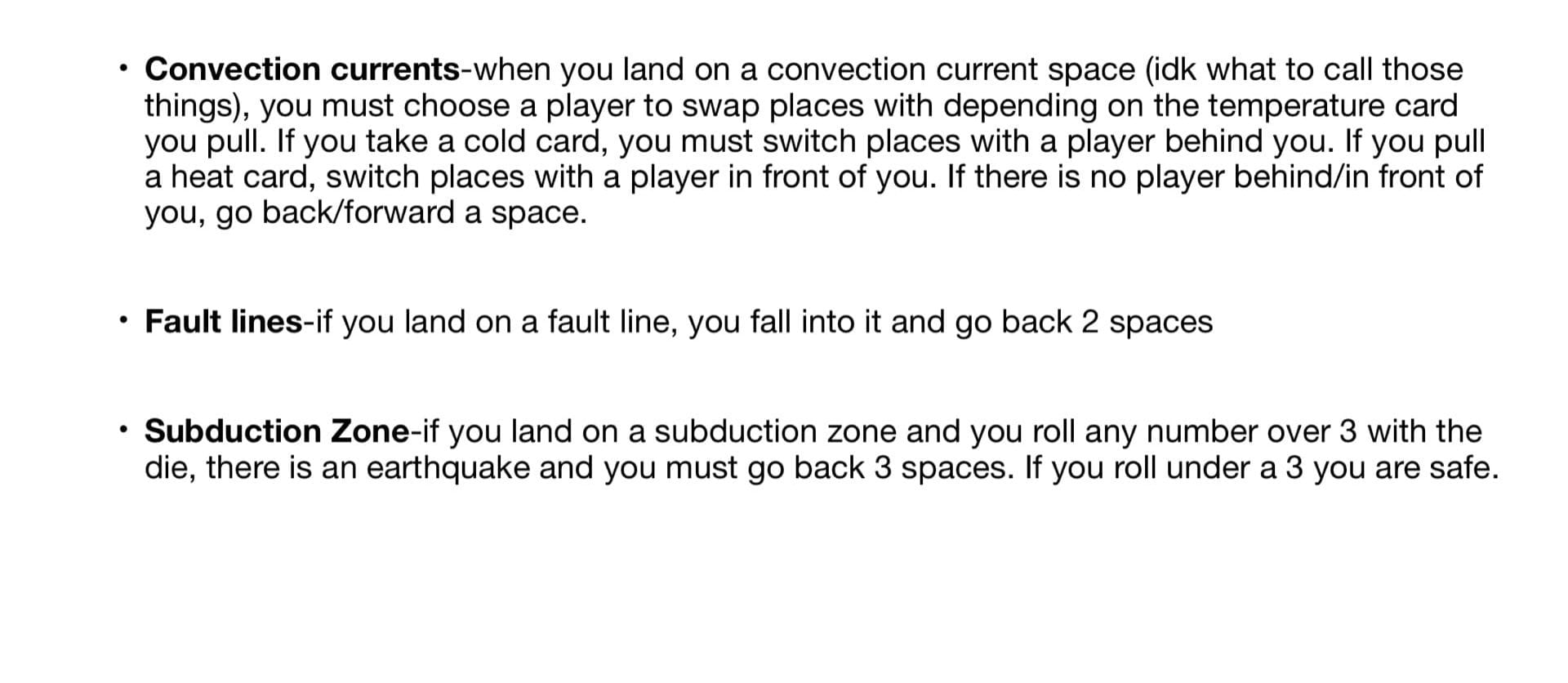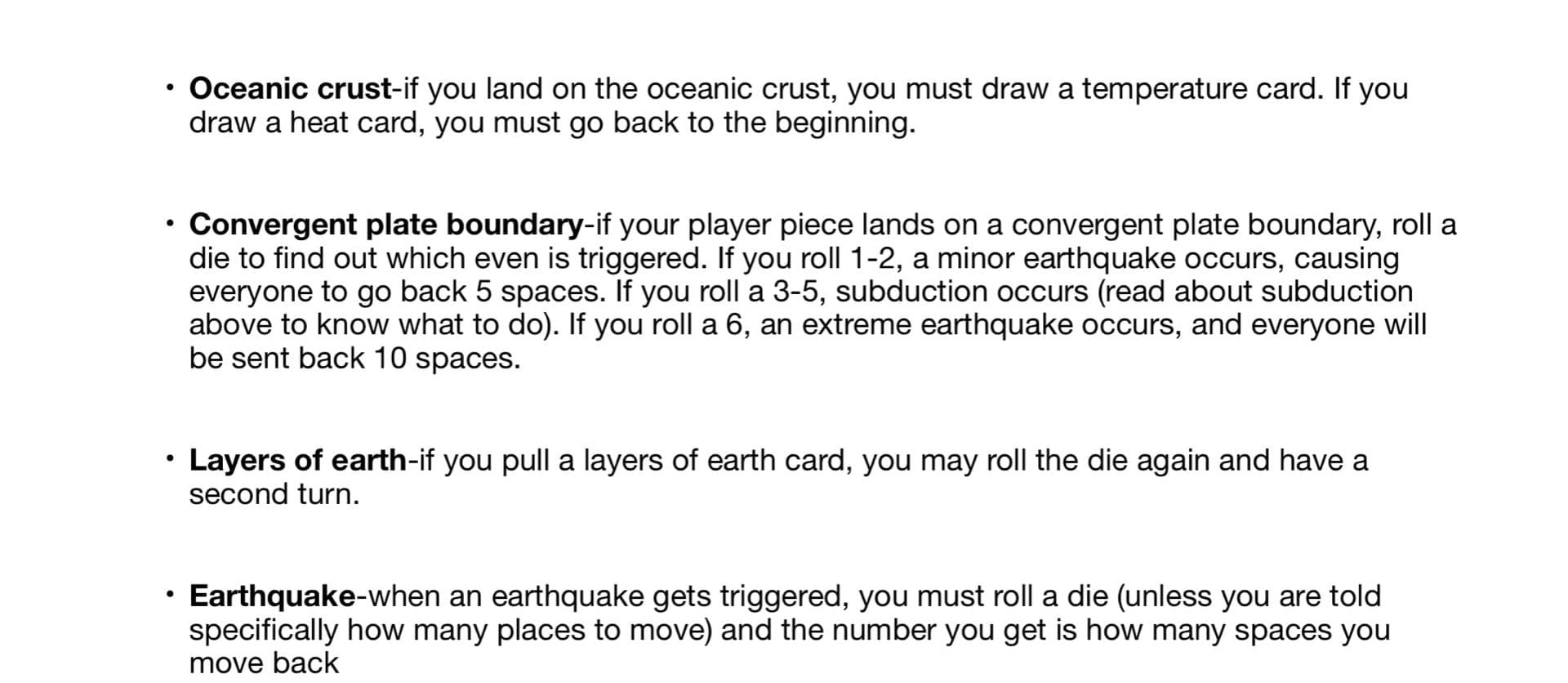We finished our first official project in plp scimatics! For this project we had to design a game about tectonic plates using probability to answer the driving question “How are thematic and mathematical elements used in game design?”
For our game we design a board game where the goal is to get to the end of the board. The different spaces made different things happen. For example if you landed on a tsunami space you would roll the die again and the number it landed on the number of spaces you would move forward. Here are the rules for each space…
For our game we were meant to incorporate probability into our game. To incorporate probability we added cards which meant there were different chances that you would get different cards. We also added a dice this adds probability because there a different chance that you will roll the right number to land on different tiles. For an example of this we had one event space that would trigger our volcano in our game ( When the volcano is trigger everyone except you goes back to the beginning and you go back 5 spaces). The probability you would roll the right number to land on this was a 1 in 24 chance. Another example is drawing an event card (If you drew 5 event cards that would also trigger the volcano) is very common because our deck is 75% event cards the rest is layers of the earth cards (If you drew one of these you would get an extra turn).
On game day I noticed a couple things that we could improve on our game. First people seemed to land on the event a lot so the game was slowed down and it got really boring. What I would have done instead is when someone lands on an event space they get to choose one person to send to the beginning to make the game more exciting and less boring. Also every time someone played the game they would get 3 or 4 event cards but never 5 so I think that should be changed to 3 event cards to trigger an event because the game didn’t go on long enough for that to happen often. Looking at other peoples game I got the idea instead of tiles we should make tectonic plates as the tiles shape and mark the spots were you can go on the board, so you can go all over the board instead of one direction. Also I would add something you needed to go across the finish line, like maybe you have to collect 3 specific cards or objects before your allowed to go across the finish line. The last thing I would change is I would have made the game easier to understand because all the different spaces did different things and it was really hard to remember so personally think I we should have made the game rules easier to understand and maybe make the consequences less harsh.
For this project there were 3 main section the first one was the theory of Plate tectonic and supporting evidence is a central theme of the game. 10 key science concepts are described. Game pieces visually represent tectonics concept. I think I did I ok on this one because we incorporated tectonic plates into our game and 10 key concepts. But i think our game could visually represent ectopic plates more because all we have was a blue board and green square tiles. The second section is all class time is used efficiently for learning and project work without distractions. I think i did well on this one the only thing i could work on is that we finished really early and we didn’t have anything to do but i could have spent some more time working on final details because are game was really lacking those. The final section is The tectonic game uses probability in each turn to determine outcomes. The probability of several example combinations of events is clearly calculated in the game instructions.This basically asked if we added probability to our games and i think we didi good on this one because we had dice and cards and the different probability of what spaces we would land on. We’re could have added more cards because we only had 4 different types of cards. But overall I think the probability in our game was good.
The driving question of this project was “How are thematic and mathematical elements used in game design?” My answer to this question is that most fun games use both thematic and mathematical design which is what makes the game exiting to play. Mathematical elements are added by the form of probability most of the time to make the game have a chance of many different things happening. The way games use thematic elements is by choosing a subject to make the game about. Choose any game it probably has a theme. Like how our game was based on tectonic plates. The 2 elements of mathematical and thematic are some off the most important aspects of a good game. That’s why most games use these. That’s my answer to the driving question,thanks for reading about my first scimatics project. Hope you enjoyed!


